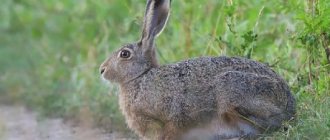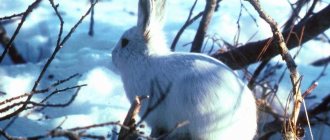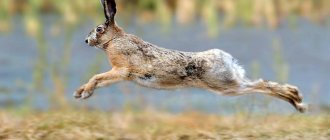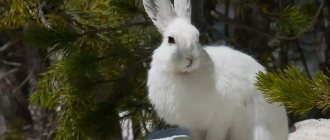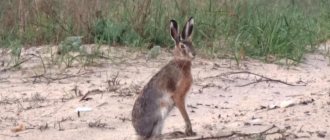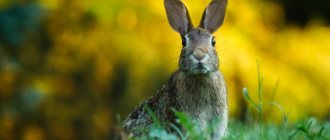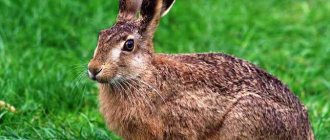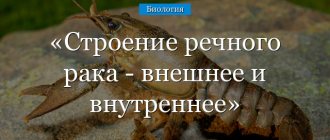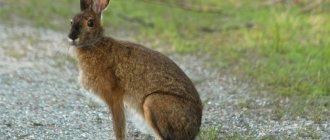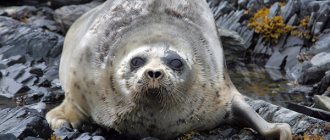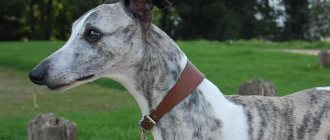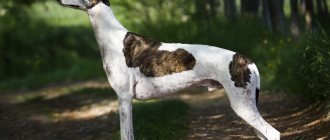RUBRICS
ADDRESS CATALOG
NEW ENTRIES
Veterinary clinics
Veterinarians
Pet salons
Pet stores
White hare: nutrition, reproduction, adaptation to life
The white hare inhabits various biotopes - from the Arctic tundra and northern coniferous forests (taiga) to the mountains, where it settles above the forest border. In many places, the mountain hare can only hide in a few shelters, so it has to endure icy wind and rain all year. The white hare is perfectly adapted to life in cold regions located in the north or high in the mountains. It can even withstand temperatures of -40 C. The white hare feeds mainly on grass, low shrubs and various perennial herbs. He remains in his shelter until dusk and only then goes in search of food.
Animals living in the southern regions of the tundra, with the arrival of winter, move to the edge of the taiga, into the boundless coniferous forests. Here they find more reliable protection from cold and wind. Snowshoe hares, which spend the winter in the open tundra, can only find shelter behind rocks and under low bushes. In Scandinavia, the white hare stays all year round in taiga regions rich in food.
Reproduction of the white hare
During the mating season, males become very aggressive towards each other. Almost the entire period they attack each other and fight for females. Mating occurs in March, but in the tundra it is postponed to a later date and occurs at the end of May. Hares are born 50 days after mating. The female feeds the hare milk once a day. The entire brood stays close to the mother, without running away. Sometimes the hare tries to ward off the enemy from the babies, pretending to be wounded.
Adaptation of a hare to life
The white hare, like many other herbivorous animals, becomes prey to predatory animals. In winter, when everything is covered with white snow, the hare's fur becomes completely white, so the animal is practically invisible on the snow and ice. In spring, the color of the white hare's coat changes again (depending on the temperature) to dark, blackish-brown or brownish-red. Such changes are driven by temperature and daylight hours. These animals simply need to adapt and blend in with their surroundings.
In places where there is no snow, the white hare does not change its dark color to white. For example, snowshoe hares that live in Northern England have variegated fur in winter. In some subspecies of the mountain hare that live in the Arctic, the coat remains white in the summer. Good vision, sense of smell and speed are also important for the mountain hare. The hare's eyes are located quite high on the sides of the head, which provides it with a very wide field of vision. The hare simultaneously examines a large area of space. Having noticed the enemy, he first freezes in place in the hope that he will not notice him. Seeing that he has been discovered, he flees. The hare digs tunnels in the snow, hiding from predators and frost.
Winter coat: very thick, especially on the ears. White coloration provides camouflage in snow-covered areas. Summer Coat: The coat in summer is not as thick and is brownish-gray or tan in color. Ears: The mountain hare has short ears, which prevents excessive heat loss. The black-tailed hare, which lives in the desert regions of California, has very long ears, which ensure good cooling of the body. Paws: The foot is covered with thick hair. Wool protects the hare from the cold and helps him stand more confidently on snow and ice.
Nowadays, the white hare is not in danger of extinction. However, its habitat in cold climates has specific characteristics, so intensive use of the Arctic and pollution of these regions gives cause for concern.
One of the most common animals in almost all corners of the planet is the brown hare. It is found everywhere except Antarctica. This animal became famous for its cautious character, its deft escape from pursuit and its quick tangling of its tracks.
The mammal is a separate species and belongs to the genus of large hares. In many countries it is one of the most popular game animals. This is facilitated by the highly developed reproductive system of hares, which can bear fruit several times a year, producing at least 8 babies at a time.
No one knows how to confuse their tracks better than a hare. This is one of the most popular fairy-tale and cartoon characters, beloved by children. Until the 20th century, not all territories were inhabited by them. But the situation was corrected as a result of the resettlement of brown hares in North America and New Zealand.
Features and habitat
Judging by the description of the brown hare , it is one of the largest eared hare among all its fellows. It reaches a length of up to 70 cm. Its weight reaches up to 6 kg.
Read also: Traditional baked goods from around the world
In the summer, for the purpose of camouflage, the fur of the brown hare becomes gray with admixtures of brown dyes. In winter it becomes somewhat lighter. A warm undercoat is formed under it.
You can distinguish a hare from all other animals thanks to its long protruding ears. This is not only the animal’s organ of hearing, but also an ideal means for saving a furry one from overheating in too hot weather. Using the areas on the ears that are not covered with hair, excess heat is released from the animal's body.
It is interesting to watch how a hare takes cover from the rain. He carefully presses his ears down to his head and carefully protects them from water. After all, they have another very important mission - to save the animal from possible danger, which the ears, like locators, detect at a great distance.
Their average length is usually about 15 cm. The tail of the brown hare is black and small in size. The eyes are red with a brown tint. Black fur can be seen on the tips of the ears year-round.
The brown hare can reach high speeds, sometimes reaching up to 50 km/h. This and the color of the coat is considered the main difference between the brown hare and the white hare. It is impossible to distinguish a male from a female by coat color.
The steppe and forest-steppe zones are the main habitat of these fast animals. Hares prefer warm and dry climates with a lot of sunny days.
You can meet hares almost throughout Europe, except Spain and Scandinavia. It has long been found in Asia, Kazakhstan, and Altai. Recently, hares have been brought to Australia, America, and New Zealand and have successfully taken root there.
Animals feel comfortable in the open steppe with sparse bushes and forest plantations. In winter, they can often be found near human habitations. This makes it easier for them to soak up the harsh cold.
The appearance of the hare hare is so clearly expressed that everyone who even meets him for the first time in his life understands that it is he, and not some other representative of the hare breed.
One of the clear signs of the brown hare is their tendency to stay in open spaces. Their most favorite habitats are agricultural lands. Places where animals never have problems with food.
Character and lifestyle
Brown hares prefer to live alone. Only during the mating season can they find a mate. It is more convenient for him to lead a nocturnal lifestyle. As soon as dusk falls, the brown hare goes out to hunt for food. The rest of the time the animal rests in a secluded place, away from possible enemies, of which the scythe has plenty.
Animals master the wonderful art of camouflage. Sometimes they can hide so much that it is impossible to notice them at all, even if they are very close.
Hares do not have one specific home. They are constantly looking for new housing for themselves. In summer, not too deep holes located in bushes or tall grass become their refuge. With great luck, the long-eared one can find an abandoned hole of a badger or fox. With less, it can simply settle under a bush.
In winter, its refuge becomes a small hole dug right in the snow. He chooses a place so that there is no wind. Hares should be careful. They can be so quiet and inconspicuous that even the most attentive predator sometimes does not notice them. Fluffy ones never make unnecessary sounds.
But in times of danger, everyone around, including their brothers, can hear their loud and shrill squeak. In addition to squeaking, hares warn of danger in another unique way - they begin to intensively drum their paws on the ground. This Morse code helps many hare hares escape from their enemies.
Basically, hares live in one place. In winter, they prefer places with little snow. Only with the formation of an ice crust do hares migrate en masse to other places. In order to find food in winter, brown hares have to travel distances of tens of kilometers.
the hare's fast and confusing tracks, he has another talent - he can swim perfectly. Danger forces the hare to make a loud chatter of his teeth. And the one who was caught emits an incredibly loud and piercing scream.
The animal has well-developed not only hearing, but also vision and smell. Therefore, it is almost impossible to sneak up to him and take a photo with the brown hare . It is also very difficult to catch up, because in fright he develops high speed.
If we compare the speed of a brown hare and a white hare, then the speed of the former is comparatively faster. It also jumps and swims better than its white counterpart. These animals have always been considered an object for hunters. They have very tasty meat and soft, warm skin.
Nutrition
This mammalian herbivore is not too picky about food. The main thing for hares is that it is there. Any field plant serves as a delicacy for them. Moreover, hares can eat it whole, right with the roots. Long-eared animals living near populated areas often raid people's gardens and eat their favorite carrots and cabbage.
Read also: How to cover euonymus for the winter
In the winter season, tree bark, plant seeds, and various remains of fruits and vegetables are used. Winter wheat, which they find under the snow, also saves them from starvation.
When visiting garden plots, hares sometimes cause irreparable harm to gardeners. Their favorite tree is the apple tree; it always suffers more than all other fruit trees.
An interesting fact is that hares are not always forced to gnaw apple trees by hunger. Animals constantly grow teeth, which they try to grind down on hard surfaces. This way you can have a snack at the same time.
Hares often have poor digestion of rough food, so they often feed on their own droppings, which helps them better absorb the necessary substances.
Relationship with a person
White hares do not disdain the proximity to human habitation.
People have always hunted white hares. These animals have both meat and fur valued. Animals cause damage to vegetable gardens and orchards. Sometimes the number of the species decreases significantly as a result of various epidemics. And in fertile years the population increases rapidly. Such bursts usually occur once every 9-12 years. White hare are not afraid of people and can allow them to come within a fairly close distance. Snowshoe hares often settle near human habitation.
If you find an error, please select a piece of text and press Ctrl+Enter.
Reproduction and lifespan
At the beginning of spring, the mating season begins for brown hares. It lasts until the beginning of winter. During all this time, the hare can have about 4 litters. It is interesting to watch the mating games of a hare and a hare.
This happens somewhat unusually for them. Most often, in many animals, competition for a female occurs between males. For brown hares, everything happens a little differently.
Between a male and a female standing on their hind legs, the so-called “rabbit boxing” occurs, during which the female tries to raise a partner. She shows her readiness to mate by running away. The weaker male usually lags behind in the marathon. The strong one wins, and he gets the honor of becoming the father of the family.
Pregnancy lasts up to 42 days. The maximum number of rabbits born reaches up to 8 individuals. They appear in a moss-covered hole dug by the female herself. For a month, the hare feeds the babies with milk.
Sometimes it may disappear for a couple of days. In such cases, another hare, the same nursing mother, takes care of the bunnies. At approximately 8 months of age, the hares become sexually mature.
The female tries not to keep the entire brood in one pile. She undertakes such a cunning maneuver so that the predator cannot attack all her offspring. The lifespan of a brown hare in the wild lasts 6-15 years.
INTERESTING FACTS. DID YOU KNOW THAT...
- Hares were often depicted in rock paintings. The ancient Romans raised hares in large stone pens.
- The jackrabbit and American pika are among the few species of mammals that can survive at altitudes above 6,000 m above sea level.
- The Alpine pika (Ochotona alpina), the steppe pika (Ochotona pusilla), which lives in the mountains of the Urals and Central Asia, the American pika (Ochotona princeps), which lives in the Rocky Mountains, and the northern pika (Ochotona hyperborea) are representatives of another family of lagomorphs.
Features of the white hare
The white hare (Latin Lepus timidus) is a small animal from a species of mammals of the lagomorph family. For this order, this is a fairly large species of hare with a body length of an adult carcass of 45-65 centimeters.
Larger individuals are also rarer; the largest white hare was recorded in Western Siberia and its length was 74 centimeters and weighed 5.5 kilograms. This type of hare has a slightly elongated body, not very long ears, large hind feet and very small front ones.
Such proportions of paws are characteristic of animals that move across the soil by jumping, as evidenced by the word “hare” itself, which comes from the Slavic “zai”, which means “jumper”.
This type of animal got its name, as you might guess, because of the white color of the fur in winter. In the snow in the field it can only be seen by its dark eyes, nose and ear tips. In summer, the white hare has a reddish-gray color, with which it also camouflages itself very well in its habitat.
In the summer, many inexperienced hunters often confuse the white hare and the brown hare because of their similarity in color, but in reality they are easy to distinguish - the hare's ears are shorter than those of the brown hare, and the hind feet are wider for ease of movement in the snow.
In winter, the similarity between the white hare and the hare is lost - the first becomes snow-white, while the second has a light brown skin. The divergence of these two types of hares is easy to see from the photo. The mountain hare sheds twice a year in spring and autumn, before the natural color of our flora changes. Typically, molting lasts 70-80 days.
In the photo there is a white hare and a brown hare
FEATURES OF THE DEVICE
The white hare, like many other herbivorous animals, becomes prey to predatory animals. Its main enemies include such predators as the wolf, lynx, eagle owl, arctic fox and golden eagle. Thus, it is not surprising that nature endowed the white hare with well-developed protective coloration, great mobility and the ability to run quickly. In winter, when everything is covered with white snow, the hare's fur becomes completely white, and only the tips of its ears remain black, so the animal is practically invisible on the snow and ice. In spring, the color of the white hare's coat changes again (depending on the temperature) to dark, blackish-brown or brownish-red. Such changes are driven by temperature and daylight hours. These animals simply need to adapt and blend in with their surroundings. In places where there is no snow, the white hare does not change its dark color to white. For example, the white hares that live in Northern England have variegated fur in winter. Some subspecies of the mountain hare living in the Arctic have white fur even in summer. Good vision, sense of smell and speed are also important for the mountain hare. The hare's eyes are located quite high on the sides of the head, which provides it with a very wide field of vision. The white hare simultaneously inspects a large area of space. Having noticed the enemy, he first freezes in place in the hope that he will not notice him. Seeing that he has been discovered, the white hare flees. The hare digs tunnels in the snow, hiding from predators and frost.
Habitat of the hare
The habitat of the mountain hare in our country is located in Siberia, the North and the Far East. The mountain hare is a forest mammal and this species lives mainly in the tundra and mixed forest, avoiding large plains, wetlands and densely overgrown forests.
In addition to our state, the animal white hare lives in many countries of Europe (mainly in its northern part), China, Mongolia, Japan and even in the countries of South America.
Snowshoe hares can be considered sedentary animals; they usually do not move over large areas unless required by the lack of food in their habitat. A white hare from its home if heavy snowfall has covered with a thick layer the low-growing grass and small shrubs that this mammal feeds on.
Read also: How do people mate?
In summer, migration may be associated with flooding (swampiness) of the area, or, conversely, excessive drought of the usual habitat.
Hunting for the white hare
Many experienced hunters prefer hunting hares over other species, because this type of hunting is the most interesting, it is also equated to sport hunting, but it also produces a lot of meat and furs.
There are several ways to hunt the white hare. The most common is hunting by drive. The company of hunters is divided into shooters and beaters. The white hare is very fast and when it runs away from pursuit, it can reach speeds of 50-70 km per hour. In winter, a person on foot or on skis will not always be able to catch up with a hare, so hounds are often used as beaters.
The beaters bring the hare to the shooting position, and the shooters, after waiting for an opportune moment, fire at the carcass. They usually shoot at the front pockets of a hare running towards the hunter. If the hare runs away from the shooter, then you should shoot just above his ears.
With this type of hunting, you need to keep in mind that the white hare runs in a circle or in zigzags. Most hunters understand why the white hare does this - it makes it harder to hit him with a gun shot.
The use of dogs in this method of hunting is due to the fact that hounds are more resilient than a person in pursuit of a hare, but sometimes during the hunt they get so tired all day that you can watch a white hare jump over a tired lazy dog and run away from her through the forest. In addition, dogs are used because they can smell the white hare and quite easily find its daytime roosts.
Another type of hunting for the white hare is finding the animal along the black trail. If the path is not covered with snow, then the snow-white skin of the snowshoe hare is clearly visible from afar.
Although this animal has good hearing, it has very poor eyesight and a hunter is quite capable of sneaking up on a hare, within shooting distance, without being noticed. Silence and attentiveness of the hunter are already very important conditions here.
In winter, the most interesting way to hunt a white hare is tracking, or in other words, reading tracks. This type of activity requires the hunter to have enormous endurance and ingenuity, as well as good knowledge of the habits of the animal. A white hare in the snow is identified by its black nose, eyes and ear tips. In the snow it is quite easy to spot on flat ground.
Research work “Adaptation of the hare and white hare to conditions of captivity”
Regional children's electronic environmental newspaper
ADAPTATION OF THE WHITE HARE TO CONDITIONS OF CAPTIVITY
Kuznetsova Yulia, Rozhneva Elena,
8th grade
These days, many wild animals are kept in captivity for various purposes. Having observed the life of animals in the living corner of the regional Palace Memorial for about 7 years, we came to the conclusion that the behavior of these animals differs from the behavior of their wild relatives.
In a living corner of the regional Palace of Youth Creativity - memorial, a group of white hares has formed, consisting of 3 males and one female. Group of different ages. One male is 4 years old, the second is 2 years old, the third male is a young year old and the female is a young year old.
The purpose of our work was to study the adaptation of the white hare to captivity conditions (the study of individual behavior, molting, as well as social behavior and learning ability).
In this regard, the following tasks were set:
1) study literature on this topic in the libraries of the city of Kirov
2) observe and analyze changes in the individual and social behavior of a hare in captivity;
3) observe the processes of autumn and spring molting of a hare in a living area, compare with molting in the wild
4) identify the learning ability of the white hare.
When conducting observations, methods of time slices and continuous recording were used according to the method of S.V. Babina. (1996), Popova S.V. and Ilchenko O.G. (1998).
LITERATURE REVIEW
The white hare belongs to the phylum Chordata, class Mammals, order Lagomorpha, family Hare, genus Hare, species White Hare (Lepus timidus L.).
The appearance of the hare is well known. Body length – 44 – 74 cm, weight 2.5 – 5.5 kg. The ears are relatively short, bent forward, reaching the end of the muzzle, but not extending beyond it. Hind limbs of medium length. The color in summer is brown, gray or brownish ocher. There is a reddish tint on the cheeks and paws. Tail without black hair. In winter, all fur is pure white. The tips of the ears are black all year round (Flint, Chugunov et al., 1970). Occasionally you come across white hare of a dark, almost black color, which do not completely turn white even in winter. Females do not differ from males in color, but they are slightly larger than males. Young hares are more curly, but do not differ in fur color (Larin, 1950).
The white hare is distributed throughout the forest zone of Europe, in Ireland, Scotland, the Pyrenees, the Alps, Scandinavia, throughout Siberia, including Kamchatka and Sakhalin, in the north of North America and Iceland (Puzanov et al., 1942).
The white hare, an inhabitant of forests and tundras, is also found in the steppe. The typical habitat of the white hare is overgrown burnt areas and cutting areas, aspen swamps in the forest, sub swamps and floodplains of forest rivers, rich in willow trees. Avoids remote, gloomy areas of the forest (Flint, 1970, Puzanov, 1942).
The hare feeds on herbaceous plants; such as clover, dandelions, mouse peas, vetch, horsetails, fireweed, wormwood. In winter, it eats shoots and bark of willow, aspen, birch, hazel, oak, and maple (Flint et al., 1970).
Snowshoe hares willingly visit salt licks. It has been established that these animals eat and gnaw everything that has a small admixture of salt, but do not touch salt in its pure form. With a lack of salt licks, white hare actively seek other sources of salt, even eating snow moistened with human and elk urine (Agafonov, 1981, Korytin, 1986).
The work of the hare's intestines is interesting. Symbiont bacteria in the cecum break down and digest cellulose, but the same hare cannot digest these bacteria: there are no corresponding enzymes in the intestine, so it swallows its feces and thus digests food twice. Eating feces (coprophagia) and secondary digestion are a characteristic feature of lagomorphs. (Mednikov, 1994).
Before thaws, snowfalls and rainy weather, the hare does not go out to feed at all, but on frosty moonlit nights it runs up to 5 - 8 km. Throughout the year, the hare changes its habitat more than once. There is no permanent lair. From their resting place to their feeding area, hares run along the same path, trampling down paths that are noticeable even in summer. In winter, such a path can even support a person, and to escape from enemies, the hare also uses these paths. Often a whole group uses the trail. Hares have better developed hearing and sense of smell, but weaker vision. Before lying down, he makes several doubles (goes back on his own trail) and sweeps (jump to the side) (Larin, 1950).
The white hare moves away from the dog in a circle, looping around a lot. The tricks of a hare running away from dogs are very varied (Korytin, 1986). A hare captured by a predator screams, emitting loud screams and moans, thereby warning other hares. In winter, it digs a shallow hole or hole in the snow to rest. In winter, the hare's hole reaches 1.5 m in length (snow is not thrown out of the hole, but becomes compacted). Hearing the enemy, the hare gets out to the exit and lies on the snow or breaks through the exit from the other side and escapes. The choice of bedding depends on weather conditions (Larin, 1950).
Molting is one of the most complex physiological processes in the life of animals, and has not been sufficiently studied in white hare. In most areas of its distribution, the color of the hare changes dramatically with the seasons. The change in color is accompanied by a change in fur, which becomes thicker and longer. However, this does not happen everywhere: in Ireland, where there is no stable snow cover, the hare does not turn white for the winter. And in the northeast of North America, where even the July temperature is from 0 to +5 degrees, the white hare is white all year round (Animal Life, vol. 6, 1971). Sometimes in the middle zone the hare’s back does not completely fade (Kaverznev, 1931). Thus, hare molt in most areas occurs 2 times a year: in spring and autumn. There is an opinion that during autumn molting the hair falls out completely, the inner layer is white and hair devoid of pigment grows (Larin B.A., 1950). Other researchers believe that during the autumn molting period, the fur does not come out, but its regrowth occurs, especially the undercoat, and depigmentation, that is, fading as a result of the loss of coloring matter (Kaverznev, 1931, Puzanov, 1942). In autumn, hair grows earlier on the abdomen, hind and forelimbs, back of the back, ears and head. Molting continues for about 90 days. In the spring, hares shed gradually, but after some time this process begins to occur at a more rapid pace. The fur falls out in clumps from the head to the back of the body. This process continues for 3 months (Larin, 1950).
The white hare has 2-3, even 4 litters per year. The first heat begins very early, usually in February. Pregnancy lasts about 50 days. There are from 3 to 6 cubs in a litter (Flint, 1970). The first litter of hares are born in March, and hunters call them “martoviki” or “nastoviki”. The bunnies will be born fully formed, a little over 100g. weights, covered with hair and sighted. Soon after giving birth, the mother feeds the hares, and they scatter in different directions, hiding in the grass. The first feeding lasts for several days, as a curdled clot of milk is formed in the stomach, which will ensure their existence for these days (Puzanov, 1942). When they get hungry, they begin to run and look for their mother. Having found it, they eat enough for a few more days. The rabbits develop very quickly and after 6-7 days they are able to eat grass themselves (Puzanov, 1942).
The number of hare is subject to great changes. Mass migrations of white hare often occur. In the fall, they can gather in flocks of 15-20 to 70-80 individuals (Doppelmeier, 1966). The number of the hare is influenced by its numerous enemies. The most fierce enemies are the lynx, fox and eagle owl; the hare also suffers from martens, ferrets and even ermine. Among the feathered predators, the hare is also pursued by large owls, eagles and the goshawk. A person hunts a hare for its meat and skin (Puzanov, 1942).
According to Brem (1992), young hares are easily tamed, respond to calls, take food from hands, and can even be trained.
The lifespan of a hare in the wild is 8-9 years (Animal Life, vol. 6, 1970).
RESULTS AND DISCUSSION
Locomotion
Observations of a hare in a living corner showed that even in a small space in its cage, the hare moves by jumping, pushing off with its long hind legs and landing on its front legs. However, if in the wild a hare makes its mark every time it approaches a bedding area, then in a living corner we have never noticed such a phenomenon in any of the four hares living here. Released from the cage, the hares move by jumping and at the slightest fear they simply jump into their cage.
We also observed that the hare can perfectly move up and down the stairs, jumping on each step.
Nutrition
In the living corner, the hares receive vegetables. grain, black and white crackers. apples, hay. The total amount of food consumed is 290 - 300g per day. Grains, crackers and apples are preferred. We noticed that the hare does not try to hold small and round pieces of food with its paws, although it is very inconvenient to eat them without holding them. This method of feeding in the wild is justified, since hares feed on grass, eating the above-ground part, or bark and branches of trees, which are also fixed and do not require support while eating.
The hare drinks often, regardless of the external temperature. The duration of one approach to a cup of water is 10-15 seconds, the frequency of approaches is once every 2-3 hours. Lacking drinks.
Use of the shelter
Watching hares in a living corner, we saw that the cage is a permanent refuge and protection from other animals, as well as people. At the slightest danger, the hare hides in its cage. Through the bars he is less timid and allows people closer. If a hare wants to enter another hare's cage, the owner of the cage kicks him out.
Sleep and rest
A hare sleeps and rests in the wild, with its paws tucked under itself, its ears folded over its back and its eyes closed. This posture of sleep and rest is necessary for quickly jumping up when an enemy approaches. In the living area, this position was preserved in wilder hares (two-year-olds and young-of-the-year). The hare, who has been living in the living area for 4 years, now has another position for sleeping and resting - often the hare lies on its side with its paws outstretched. We explain this by the fact that this hare has a dulled sense of danger, since he does not see any enemies among the animals and people around him.
Selection
According to the literature, hares mark their feeding area with feces. In the living area, hares leave feces near the cages of other hares. In their cage, they arrange a toilet in the corner opposite from the bed.
Voice
Like the wild, hares make sounds of fear and pain, similar to the crying of a small child and sounds similar to screams. Dissatisfaction is expressed by snorting.
Aggression
As in the wild, the hare shows aggression towards its own kind. It manifests itself in striking with the front paws - both together - and snorting. The same type of aggression manifests itself towards humans, but only in more tame hares.
Exploratory behavior
He does not walk around the perimeter of an unfamiliar territory, but first studies it for a long time while sitting still, and then sits down in a column and looks around. With quick jumps he crosses it in different directions. An unfamiliar object above it (a snag, a trash can, new furniture) causes fear and a jump to the side of the object, examining it visually from a distance, then approaching and sniffing. He is not afraid of unfamiliar objects if they are lower than him (foam objects of various shapes, toys, lumps of paper).
Learning
Our hare, who has been living in the living area for 4 years, has learned to respond to a nickname and can take food from hands.
He acquired the nickname during the 3rd year of his life in captivity. In the first year he learned to open his cage from the inside (insight) by pressing the door with his muzzle and front paws. In the third year, he began to open his cage from the outside using his teeth, grabbing the door partition with them (Appendix 1). In the fourth year, the hare learned to open the doors of tables, cabinets and other cages with the help of his teeth.
Relationships between young of the year living in the same cage.
The cage, measuring 1.2 x 1 m, is divided by the hares into 2 sections: at the far end of the cage there is a female section, closer to the door there is a male section (Appendix 2). The hare's beds are located in opposite corners of the cage. In the relationships between hares, the dominance of the male is clearly visible. This is indicated by the fact that the male is the first to approach the cup of food and does not allow the female to approach it until he has eaten. The average individual distance between hares in a cage is ~83cm and ranges from ~71 to ~90cm (Table 1). Violation of this distance and invasion of someone else's individual area in the cage is accompanied by aggression on the part of both the male and the female, however, the female shows aggression only when the male directly approaches her, while the male shows aggression at the slightest attempt by the female to invade his individual area.
Relationships in a group of hares.
The relationships of all 4 hares were studied while walking them in one large room measuring 8.7 x 5.5 m. An analysis of observations showed that even a group of hares of the year remains the leader, although, according to Brem (1992), old hares kill young ones if they are put in a cage with them, and, moreover, do not accept the leadership of a young one. The leadership of the male yearling is expressed in the fact that he is more active during walks, more often makes contact with other hares, and chases them.
Each walk of the hares begins with mutual sniffing (Appendix 3). They can sniff not only the muzzle, but also any other part of the body. Sniffing begins from the upper lip of the muzzle, to the ears, along the forehead, then sniffs the lower lip, throat and neck. Sniffing occurs repeatedly throughout the walk (from 12 to 36 times within an hour). The duration of sniffing does not exceed a few seconds.
A study of the individual distance between hares during walks showed that the smallest individual distances are maintained between a female of the year and a 2-year-old male and amount to ~168 cm. These hares occupy a subordinate position in the group, so they try to stick together.
The average individual distances between the leader and other group members are ~239cm and range from ~232 to ~284cm. The greatest distance is observed with a hare that lives in a living area longer than other hares and lives separately in another room. During walks, this hare shows the least activity compared to the others and makes less contact with other hares.
A study of the synchronicity of behavior in hares showed that for hares living in one cage it averages 33%, and for hares living alone it is only 15%. Thus, hares living together have more similar behavioral reactions compared to those living alone. But the behavior is most synchronous in subordinate, non-tame, hares (~50%), despite the fact that they live in different cages.
Relationships with other animals
As a result of four years of observations, we came to the conclusion that hares very quickly get used to the conditions of a living area and do not show fear of any animals. This is consistent with the data of S. Kucherenko and other zoologists, who claim that hares are not so much cowardly as they are cautious and are good at distinguishing between danger and safety. Not seeing any danger from the animals of the living corner, hares treat them indifferently, and even towards some with friendliness.
In the living corner, all the hares live in their cages with guinea pigs. Observations have shown that hares do not show aggression towards them, are friendly and even protect them. You can often see them licking guinea pigs. It can be assumed that hares lick sweat secretions containing salt from the fur of guinea pigs, because Literary sources indicate a great need for this substance in all lagomorphs and, especially, in white hares.
It was interesting for us to observe the relationship between a hare and a hunting dog. A dachshund was brought into the living corner. which, being a hunting dog, had never hunted or even been in the forest. When a dachshund dog was brought to a cage with a 4-year-old hare, he immediately jumped up to her and began to sniff her through the bars. The dachshund began to bark, the hare’s reaction was instantaneous - he jumped back, began to rush around the cage, then, opening its door, jumped out and ran around the perimeter of the room, while trying to take notes, although in moments of danger he always hid in the cage, considering it his refuge . The dog rushed after the hare, and it took a lot of effort to stop it. After the experiment, they were able to force the hare into the cage with difficulty.
Turning on a tape recording of a dog barking showed. that barking makes a strong impression on the hares - they begin to move their ears, raising themselves, looking around. The sounds of a wolf, jackal, and hyena cause the same reaction in hares. Hares do not react to the sounds of other animals (the growl of a tiger, the squeak of a rat, the roar of a deer).
This experience gives reason to assume that the hare is genetically imprinted not just with the image of the enemy, but with his sounds or an image accompanied by sounds.
Relationships with a person
Of the four hares, two are tame, two are non-tame. Of the non-tame hares, the two-year-old had a large wound measuring 9 x 6 cm on his side, which he received as a result of being captured at the age of 3-4 months; a female yearling suffered temporary paralysis of her hind limbs as a result of being squeezed in her hands at the age of about 2 months. Despite the same attitude of people towards hares in a living corner, these two never became tame. They begin to rush around the cage when their food cups are taken from them. When released from their cage, they stay closer to each other than other hares, and immediately run away when a person approaches.
Of the tame hares, the most tamed is a 4-year-old male: he can take food from a person’s hand, comes close to a person, sniffs him, lets him stroke him, but only when he sees a hand and a person. He can let himself be stroked from the back, but only by a person he knows very well. When stroking it is kept in constant tension. Challenges a person to a game, hiding from him behind a cabinet, door, cage and looking at the person. Having made sure that the person is heading in his direction, he runs out and hides again, looking, and never makes discounts or estimates, and runs away not far away. If a person and a hare are separated by a grill, then the hare rises on its hind legs, places its front legs on the person’s lap through the grill and sniffs.
Shedding
Our observations showed that in the conditions of a living corner, autumn shedding does not lead to a clearly noticeable loss of summer wool, since we did not notice any fallen hairs when cleaning the cages. Stroking a hare with your hand also does not indicate the presence of falling fur. Autumn molting of hares in a living area may have occurred due to an increase in downy cover and loss of dye in the summer wool, which corresponds to the data of V.N. Kaverznev. (1931), Puzanova I.I. (1942) and refutes the point of view of Larin B.A. (1950).
Spring shedding occurs rapidly: the fur falls out in clumps, starting from the head to the back of the body.
The longer a mountain hare lives in a living corner, the slower the molting proceeds: in a hare that has lived in a living corner for 4 years, molting begins later (in the second ten days of September), the forehead remains dark throughout the winter and the dark color of the guard hairs remains in the background. white underfur on the back and sides. The reason for this phenomenon is difficult to explain, since it is apparently associated with changes in physiological processes due to changes in living conditions (constant high temperature, increase in daylight hours due to artificial lighting). Obviously, the hare is gradually losing those adaptations that help him survive in the wild.
CONCLUSIONS
A study of the behavior of the white hare in captivity showed that certain vital behavioral acts remained unchanged: behavioral features during feeding, excretion, voice, aggression, and research activity. Others have changed. In individual behavior: locomotion, use of shelter, comfort behavior. In social behavior: the emergence of hierarchy, the presence of a leader, a dulling of the sense of danger in relation to other animals and humans, which is observed in hares who did not suffer trauma at an early age.
The mountain hare's ability to learn is quite high and is more pronounced in hares with a high degree of domestication.
As the hare adapts to the conditions of the living area, one of the most important adaptations to survival gradually changes - the process of autumn molting. It becomes incomplete and proceeds more slowly compared to the wild.
Thus, we can say that the changes in behavior noted in the work help the hare adapt to unusual living conditions.
CONCLUSION
We would like to hope that the results of our research on this topic will bring some clarity to controversial issues regarding the biology and behavior of the hare.
We recommend the white hare for keeping in live corners, since our research has shown that if certain conditions are created, it can live in captivity for quite a long time and be a very interesting object to observe.
LITERATURE
1. Popova S.V., Ilchenko O.G.
Agafonov V.A. Salt licks for white hares (Lepus timidus). - In the book: Behavior of game animals. Kirov: Volgo-Vyatka Prince Publishing House, 1981.
Akimushkin I.I. Animal world. Mammals or animals. - M.: 1988.
Brem G. Animal life. T. 1. Mammals. - M.: Terra, 1992.
Doppelmayer G.G. , Malchevsky A.L. and others. Biology of forest birds and animals. - M.: Higher School, 1966.
Life of animals . T.6.- M.: Education, 1971.
Korytin S.A. Habits of wild animals. - M.: Agropromizdat, 1986.
Kucherenko S.A. Lumpy-eared acquaintances. // Young naturalist No. 1, 1986.
Larin B.A. Hares. - M.: Zagotizdat, 1950.
Mednikov B.M. Biology: forms and levels of life. M.: Education, 1994.
Puzanov I.I., Kiparisov G.P., Kozlov V.I. Animals, birds, reptiles and fish of the Gorky region. M.: OGIZ, 1942.
Flint V.E., Chugunov Yu.D., Smirin V.M. Mammals of the USSR. - M.: Mysl, 1970.
Reproduction of the white hare
The white hare is a pack animal. Usually flocks consist of 30-50 individuals. If a flock of white hares grows larger than average, then this becomes very dangerous and often leads to the death of young broods due to lack of food in the habitat.
Breeding of snowshoe hares in most of their range occurs twice a year. At this time, the females emit a peculiar cry, the so-called tumbling, thereby attracting the attention of the males. The first rut occurs in February-March, the second in May-June.
In central Europe, three ruts of white hares are common, with the third occurring in August. Lambing occurs after 45-55 days, it mainly takes place in open areas and only in very cold winters can it occur in burrows that females dig for the birth of offspring.
The average litter size is 5-7 hares per litter, occasionally reaching 10-11 individuals. Hares are born covered with thick fur and immediately sighted; already on the first day of life they are able to move independently. After about a week, they begin to feed themselves with grass.
They become completely independent after two weeks. At the age of ten months, the hares reach sexual maturity and can reproduce. The average lifespan of white hares is 5-7 years, and, starting from the fourth year of life, the fertility of females becomes noticeably less.
In the photo there are baby hare
LIFESTYLE
Snowshoe hares spend most of their lives alone. With the arrival of winter in the Arctic, hares begin to unite in small groups. In winter, living in groups provides them with better protection from predators. In case of danger, the entire group scatters, which confuses the enemy for a while, so the whites have a greater chance of salvation. Animals living in the southern regions of the tundra, with the arrival of winter, move to the edge of the taiga, into endless coniferous forests. Here they find more reliable protection from cold and wind. Snowshoe hares, which spend the winter in the open tundra, can only find shelter behind rocks and under low bushes.
In Scandinavia, the white hare stays all year round in food-rich taiga regions. The Alpine hare lives at high altitudes. The number of white hares depends on the availability of food.
Nutrition
The diet of the white hare depends very much on seasonality and habitat. In summer, the main diet consists of grass crops such as clover, dandelion, some types of sedge and other grasses. In winter, food is much poorer and during this period the mountain hare is adapted to eating the bark of bushes and some trees.
A special delicacy for this type of hare during the snowy season is the bark of aspen and willow. In addition to wood and grass, the white hare feeds on the shed antlers of elk, deer, and roe deer, as well as the bones of dead animals.
The white hare feeds mainly at night in the dark. During the night it can run many kilometers in search of food in order to get the daily ration it needs, and these may not necessarily be long distances, it may be a small area covered several times. During the day, he spends most of his time lying down and it is at this time that he is hunted, because in this state the white hare is calmer.
What does a white hare eat?
White hares are herbivorous mammals. The most favorite food is young shoots and grass. The mammal prefers to choose clover, dandelions, and cereal plants.
If they come across fruit trees, they will not refuse to gnaw their bark. In addition, the food includes mushrooms, seeds, and legumes.
In winter, they have to escape hunger using the bark of trees, mainly birch and willow; they also eat branches. They take out cones from under the snow and dry grass. They may eat berries left on some bushes.
After a foray for food, they return to the hole, confusing their tracks. They deliberately run in circles, jumping far away from the main path in order to confuse the pursuer. These habits of the white hare allow you to save life.
